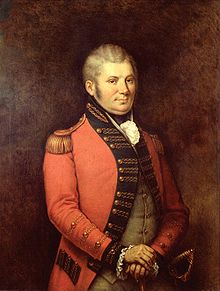
Back جون جريفز سيمكو Arabic جون جريفز سيمكو ARZ Джон Грэйвс Сімка Byelorussian جۆن گرەیڤس سیمکۆ CKB John Graves Simcoe German John Graves Simcoe Spanish جان گریوز سیمکو Persian John Graves Simcoe Finnish John Graves Simcoe French John Graves Simcoe Hausa
John Graves Simcoe | |
|---|---|
 Portrait by George Theodore Berthon | |
| 1st Lieutenant Governor of Upper Canada | |
| In office 1791–1796 | |
| Monarch | George III |
| Governor General | Guy Carleton, 1st Baron Dorchester |
| Premier | William Pitt the Younger |
| Preceded by | None |
| Succeeded by | Peter Russell |
| Personal details | |
| Born | 25 February 1752 Cotterstock, Oundle, England |
| Died | 26 October 1806 (aged 54) Exeter, England |
| Spouse | |
| Children | 11 |
| Parent(s) | John Simcoe Katherine Simcoe |
| Education | Exeter School, Eton College, Merton College, Oxford |
| Occupation | Military officer, Colonial administrator |
| Signature | |
| Military service | |
| Allegiance | Great Britain |
| Branch/service | British Army |
| Years of service | 1770–1806 |
| Rank | Lieutenant-general |
| Unit | 35th Regiment of Foot 40th Regiment of Foot |
| Commands | Queen's Rangers 22nd Regiment of Foot Commander-in-Chief, India |
| Battles/wars | |
Lieutenant-General John Graves Simcoe (25 February 1752 – 26 October 1806) was a British Army general and the first lieutenant governor of Upper Canada from 1791 until 1796 in southern Ontario and the watersheds of Georgian Bay and Lake Superior. He founded York, which is now known as Toronto, and was instrumental in introducing institutions such as courts of law, trial by jury, English common law, freehold land tenure, and also in the abolition of slavery in Upper Canada.
His long-term goal was the development of Upper Canada (Ontario) as a model community built on aristocratic and conservative principles, designed to demonstrate the superiority of those principles to the republicanism of the United States. His energetic efforts were only partially successful in establishing a local gentry, a thriving Church of England, and an anti-American coalition with select indigenous nations. He is seen by many Canadians as a founding figure in Canadian history, especially by those in Southern Ontario.[1] He is commemorated in Toronto with Simcoe Day.
- ^ Inoru, Kita (4 August 2014). "John Graves Simcoe: The Man Behind Toronto's Simcoe Day".